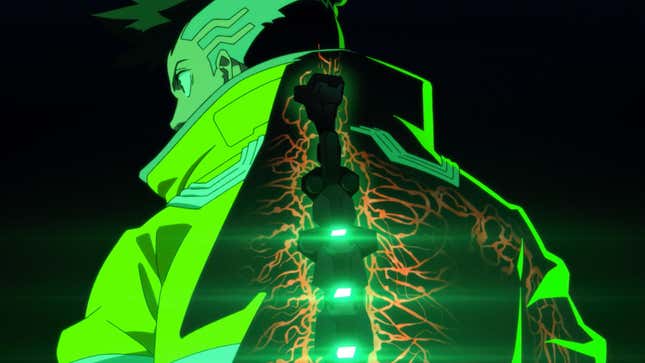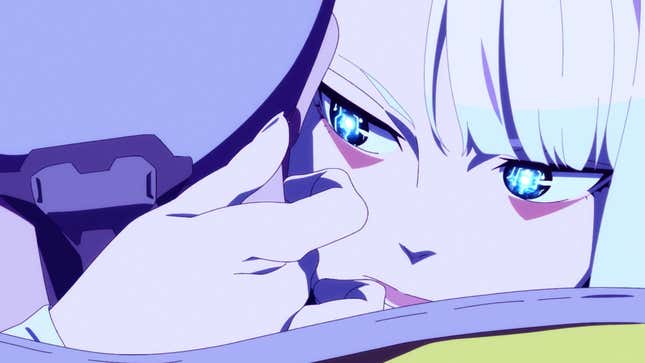
The tag “Netflix original anime series” has had its fair share of ups and downs over the years, sometimes being affixed to bold, exhilarating new shows, at other times to deflating disappointments. However, Studio Trigger and CD Projekt Red’s Cyberpunk: Edgerunners tips the scales in a significant way toward proving that, when the right people are behind a project, the streaming service can be a force to be reckoned with in the anime sphere.
First announced even before Cyberpunk 2077 released, back in June 2020, Cyberpunk: Edgerunners is a standalone, 10-part anime series by CD Projekt Red, Netflix, and Studio Trigger, the anime collective behind shows like Gurren Lagann and Kill la Kill. The show follows a street kid named David Martinez who, after a near-death experience following a hit-and-run, joins a crew of eccentric edgerunners looking to make ends meet by completing a slew of dangerous cyber-heists.
While its trailers would have you believe that Edgerunner’s gritty action and gratuitous, NSFW cyber-sex scenes are the glue that holds this show together, they actually just serve as the show’s very stylish set dressing. The real main course is the emotionally resonant story of how David transforms from an impoverished street kid to made man.
Read More: Cyberpunk 2077 Getting First Expansion Next Year, Keanu Reeves To Return
While Cyberpunk 2077 follows the story of V, an adult corpo, nomad, or street kid (depending on your preference) who’s on their way to becoming a power player in Night City, Edgerunners instead follows a teenager attending a prestigious high school. On paper, the trope of an anime following the exploits of a teenager has become so well-trodden it’s on the verge of becoming an uninspired standard in the medium, but Edgerunners utilizes this premise as a much-needed opportunity to give the transhuman politics of 2077 new dimensions, showcasing how its last-stage cyberpunk capitalistic world crumbles down on top of an impoverished Latino kid who’s just trying to get by.
Within the show’s first three episodes, we see how the income inequality that plagues Cyberpunk’s superficially shiny techno-paradise impacts the lives of young people. Although the private school David attends attempts to obfuscate poverty through things like having kids wear uniforms, unlike his yuppie classmates, David has to peddle black market goods in order to afford the “fossil-tech” implants he needs in order to get by in school. Although David puts on a trademark Studio Trigger cool guy attitude, a-la Kamina from Gurren Lagann, the façade serves more as a shield to protect him from the onslaught of discrimination he faces on a day-to-day basis.

If you had the misfortune of attending college during the height of the pandemic, David’s plight will feel painfully relatable. Basically, replace having shitty internet during a class Zoom meeting and scouring the web to download outrageously overpriced PDFs of textbooks with derailing braindance instructions because your faulty implant chips bugged out everyone’s lesson.
After David and his single mother, Gloria, get caught in the crossfire of a drive-by, resulting in his mother’s untimely death, David has the unenviable task of paying off her medical bills and scrounging up enough eddies for rent. This all comes to a head when David has a chance encounter with Lucy, a sardonic girl with hair like the Youtuber The Sphere Hunter, who introduces him to a band of edgerunners. After discovering that his mother did some work with the edgerunners to pay for his high school tuition, David opts to “chrome the fuck up” by installing a dangerously powerful Sandevistan speedware and joins the gang.
Within the group of edgerunners, David finds himself at the center of a ragamuffin-found family, evoking the vibes of groups like the squad aboard the Normandy in Mass Effect 2 and the crew of the Serenity in Firefly. Although David becomes a hotshot edgerunner, the show does a good job of not sweeping his past trauma under the rug.
Read More: Cyberpunk 2077: The Kotaku Review
Although David is a bonafide criminal, he can’t bear the weight of taking a life, often having flashbacks of his mother’s body. Also, David is a soft boi who doesn’t like the taste of alcohol and who wears his mother’s jacket like a comfort blanket wherever he goes, and that’s just precious. While the criminal underbelly of Cyberpunk’s mythos attempts to corrode David’s innocence, the ebb and flow of his blossoming romantic relationship with Lucy serve both as David’s and the show’s emotional anchor.

At the crux of David and Lucy’s relationship is an ongoing conversation about their dreams. While David develops the trait of co-opting the dreams of his fallen comrades both literally and figuratively, carrying on their aspirations and affixing their cybernetic upgrades to his person regardless of the toll it takes on his mind and body, Lucy dreams of both going to the moon and, most importantly, of David not having to fight to live every single day. The powerful connection between them fuels a love story that feels intimate and grandiose at the same time, and that’s ultimately deeply moving.
Edgerunners is Studio Trigger at its finest. It’s almost as if you can see shades of the anime studio’s previous projects in every corner of Edgerunners. It’s got Kill La Kill’s stylistic use of big-blocky overlay text (with the added bonus of snazzily incorporating 2077’s in-game HUD), Gurren Lagann’s dual extreme close-ups during tense conversations, and Brand New Animal’s pastel cityscape filled to the brim with intricate designs of its diverse and colorful citizens. Unlike most Netflix shows and anime that overstay their welcome by being two or three episodes too long, Edgerunners maintains its focus by telling a tight story and wrapping it up neatly in ten episodes.
While detractors of Studio Trigger’s output regard the anime powerhouse as prioritizing style over substance, Cyberpunk: Edgerunners definitely has its neon-drenched cake and eats it too by telling its own original story that eclipses that of the video game it’s associated with.
Read More: Citizen Sleeper Dev Wants To See Cyberpunk Genre Freed From Stagnation

Edgerunners serves both as an excellent introduction to the world of Cyberpunk 2077 and a more-than-competent standalone anime series. Instead of coming off as a derivative of Akira or Ghost in the Shell like so much cyberpunk media, Edgerunners utilizes the anime medium to expand upon 2077’s mythos in ways only Studio Trigger could.
While Trigger is known for its balls-to-the-wall animation and frenetic action scenes, its antics within Edgerunners are reined in, allowing for quiet and contemplative moments to breathe and not get drowned out by bombastic action. But when the action hits, it hits, dialing the show’s pace all the way up to 11 with deliciously gory and gnarly fights.
Castlevania and Arcane proved that video game adaptations could be a paradigm shift for the streaming service and now Edgerunners has demonstrated that the feat was no fluke. Who knows, maybe Edgerunners will inspire Netflix to go the route of creating more anime adaptations of popular IP instead of habitually rushing toward the “In case of emergency, break live-action glass” lane that the platform has so publicly crashed and burned with in the past.